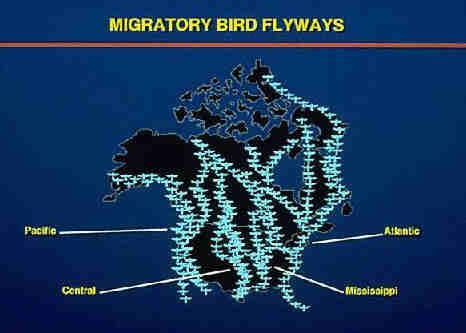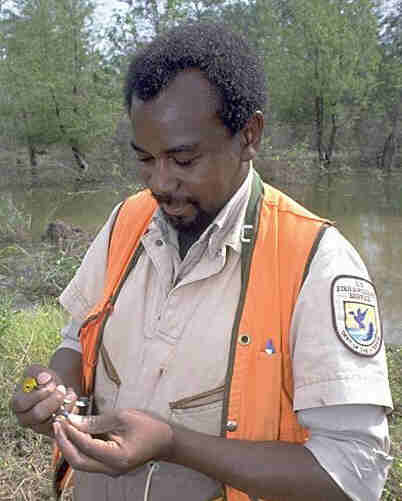| Every state has at least one national wildlife refuge, and most have
several, so pick up the phone and call to uncover local angles on these
great features:
 Amazing
Wildlife: You can find just about everything that walks, crawls, swims
or flies on a national wildlife refuge somewhere. From migration to procreation
to hibernation, step behind those "Blue Goose" refuge boundary signs and
discover a fascinating wildlife story for every season. Amazing
Wildlife: You can find just about everything that walks, crawls, swims
or flies on a national wildlife refuge somewhere. From migration to procreation
to hibernation, step behind those "Blue Goose" refuge boundary signs and
discover a fascinating wildlife story for every season.

Flyways – Highways in the Sky: Refuges dot the nation’s major
flyways – corridors for bird migration – serving as much needed reststops.
For example, 90 percent of the Pacific flyway population of long billed
dowitchers will stop at Stillwater NWR in Nevada each spring on their way
back north from the tropics. Drop by your local refuge during the spring
or fall and ask about the remarkable journeys made by the refuge’s guests.
Local History: The first refuge was established nearly 100 years
ago to protect pelicans from market hunters who wanted their feathers for
ladies' hats! When was your local refuge established, and why? How has
the community and the landscape changed since then? What changes will come
in the next 100 years?
 Wildlife
Management Behind the Scenes: Bring along your camera as refuge staff
demonstrate how they manage soil, water, fire, and vegetation to nurture
a variety of wildlife species. Take a closer look at how refuge staff improve
habitat to attract waterfowl and songbirds. Is there a lesson there you
can pass on to local hunting or gardening clubs? Wildlife
Management Behind the Scenes: Bring along your camera as refuge staff
demonstrate how they manage soil, water, fire, and vegetation to nurture
a variety of wildlife species. Take a closer look at how refuge staff improve
habitat to attract waterfowl and songbirds. Is there a lesson there you
can pass on to local hunting or gardening clubs?
 Resources
at Risk: If you prefer stories with an edge, ask the refuge manager
about the challenges the refuge is facing. What is the source of that water
pollution threatening the refuge's wetland inhabitants? What are the implications
of that proposed mine... or dam... or shopping mall for the refuge? Resources
at Risk: If you prefer stories with an edge, ask the refuge manager
about the challenges the refuge is facing. What is the source of that water
pollution threatening the refuge's wetland inhabitants? What are the implications
of that proposed mine... or dam... or shopping mall for the refuge?
 Outstanding
Outdoor Recreation and Education: Refuges abound with opportunities
for bird watchers, hunters, anglers, wildlife photographers, students,
and just about anyone else who wants to experience wildlife up close and
personal. Drop by a nearby refuge and learn about local recreational and
educational opportunities your readers and viewers may have overlooked. Outstanding
Outdoor Recreation and Education: Refuges abound with opportunities
for bird watchers, hunters, anglers, wildlife photographers, students,
and just about anyone else who wants to experience wildlife up close and
personal. Drop by a nearby refuge and learn about local recreational and
educational opportunities your readers and viewers may have overlooked.
 Colorful
Personalities: Dedication and esprit de corps are the hallmarks of
refuge staff and volunteers. One refuge employee was recently recognized
for never missing a day of work as the only maintenance worker for 4 separate
refuges -- at 90 years old! Almost 20 percent of the work on refuges is
performed by volunteers, and their stories can inspire others to begin
pitching and take ownership of the natural heritage we all share. Colorful
Personalities: Dedication and esprit de corps are the hallmarks of
refuge staff and volunteers. One refuge employee was recently recognized
for never missing a day of work as the only maintenance worker for 4 separate
refuges -- at 90 years old! Almost 20 percent of the work on refuges is
performed by volunteers, and their stories can inspire others to begin
pitching and take ownership of the natural heritage we all share.
Passing on Outdoor Traditions: When National Wildlife Refuge
Week, National Fishing Week, National Hunting and Fishing Day, and other
events roll around each year, refuges step up to the plate with fishing
derbies, wildlife art, competitions, and festivals. Which is bigger, the
smile on a kid's face or that first fish at the end of his line? It's a
great photo either way. Uncover heartwarming stories of people discovering
new horizons in the outdoors and show the world what that first trophy
can mean.
Civic Participation: Nearly 200 grassroots community organizations
have sprung up to support their hometown wildlife refuge. Often going by
such names as "Friends of Anahuac Refuge," these groups help recruit volunteers,
lead birdwalks and other public activities, and participate in most other
aspects of refuge management. These groups can be an invaluable resource
for journalists who are looking for informed opinions on the refuge, and
most can be located by following this link: http://refugenet.org/new%20friends%20connect/index-rsgdir.htm.
To get started, learn more or request a copy of the National Wildlife
Refuge System video, call (202) 208-5634 or write refuges100@fws.gov
|


